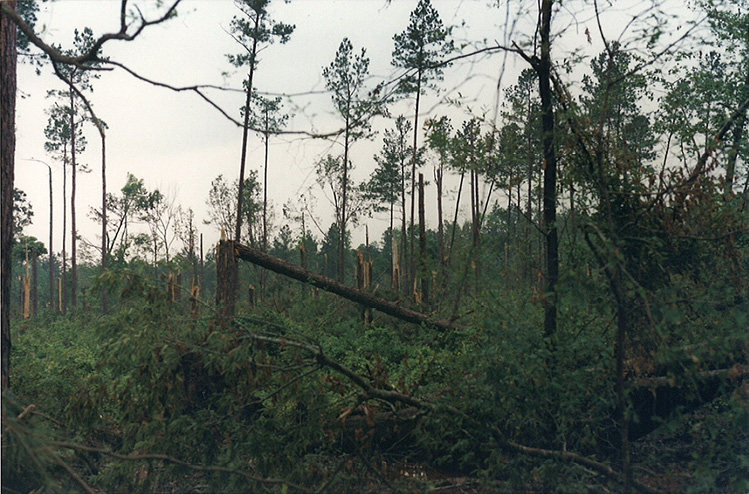Disaster Preparedness: Tree Removal and Timber Recovery Issues

After hurricanes and tornadoes have passed, homeowners and landowners are faced with cleaning up the aftermath. Mississippi State University Extension specialists offer the following tips for anyone beginning to clear debris after a disaster.
Tree Removal
- Do not use a chainsaw if you are not familiar with using them. Remember, anything that will cut wood will also cut you.
- Read and understand the chainsaw manufacturer’s operating and safety instructions in the owner’s manual.
- Be sure you are familiar with your chainsaw before operating it. Make sure that safety features, such as chain brakes and kickback chains, are functional.
- Make sure the chain is sharp. Let the saw do the work. Don’t try to force the saw through whatever you are cutting.
- Wear protective clothing: hard hat, safety glasses/goggles, safety shoes, gloves, and trim-fitting clothes.
- Always start the saw on the ground.
- ALWAYS keep both hands on the handles and away from the bar. This is important as chain brake safeties are tripped by the left hand in the event of kickback.
- Cut only on the right side of your body. The vast majority of chainsaws are designed for right-handed operators. There are a few left-handed models on the market, and these should be operated on the left side of your body.
- Cut below your head. Never cut over your head.
- Cut with the lower edge of the saw blade whenever possible. Cutting with the tip invites injury from saw kickback.
- Never put yourself in a position where you cannot get out of the way of moving portions of the tree or where the tree can pin you.
- Avoid tight spots or awkward positions when cutting.
- Be careful when cutting bent limbs or branches. They are under pressure and can snap back and hit you.
- Never leave the ground unless you have had the necessary training and are using safety equipment. Never work alone above the ground. Do not cut limbs from a ladder. Even simple tasks on the ground become complicated when up in the air.
The bottom line is don’t take risks. Cutting that last limb or log is not worth injury or death. Rarely is there a cutting job that cannot wait for professional help.
Timber Recovery
Losses to timber stands are of particular concern because timber is an important asset. For tax purposes, landowners need to document catastrophic events and resulting timber losses. Save a copy of your local newspaper to document the event, and take pictures to show property damage before cleanup begins.
You can claim timber losses from hurricanes or other natural disasters as a “casualty loss” if timber has a book value or basis. Sales involving involuntary conversions of timber due to a casualty are subject to capital gains tax. Such tax may be postponed if you reinvest proceeds in qualified replacement property according to IRS rules. For more information regarding casualty loss and taxes, please see MSU Extension Publication 2619 Frequently Asked Questions about Timber Casualty Losses.
The greater the forestry investment and/or financial loss, the more important role a registered forester should play in the process. Foresters can provide official documentation detailing both quality and quantity of the losses. If losses are significant, salvage cutting and sale of some or all of the affected timber may be necessary. When salvaging timber, place a priority on trees that have the highest value, are easiest to cut, and/or are most perishable. For example, sawtimber salvage should take precedence over pulpwood salvage.
Sell damaged timber promptly. Delaying harvest will quickly result in insect and disease problems, drastically reducing the value of salvaged material. Also, be aware that a large quantity of timber coming into the market after a natural disaster typically reduces timber prices.
Timber is still a solid investment in Mississippi. However, like most investments, growing timber does carry risks. You should counter these risks by treating timber as part of a balanced portfolio with other assets of differing risk factors. If timber is your only investment asset, consider insurance on standing timber. For more information regarding timber insurance, please see MSU Extension Publication 2911 Risk Management Options for Family Forests: Timber Insurance. Following the advice of a registered forester and an accountant can minimize losses from natural disasters and increase the profitability of forestland in the future.
Additional Reading
Henderson, J., & L. Garnett. 2018. Risk Management Options for Family Forests: Timber Insurance, Mississippi State University Extension Publication 2911.
Henderson, J. 2019. Frequently Asked Questions about Timber Casualty Losses, Mississippi State University Extension Publication 2619.
Information Sheet 1708 (POD-08-23)
Revised and distributed in Mississippi by Brady Self, PhD, Associate Extension Professor, Forestry.
The Mississippi State University Extension Service is working to ensure all web content is accessible to all users. If you need assistance accessing any of our content, please email the webteam or call 662-325-2262.




